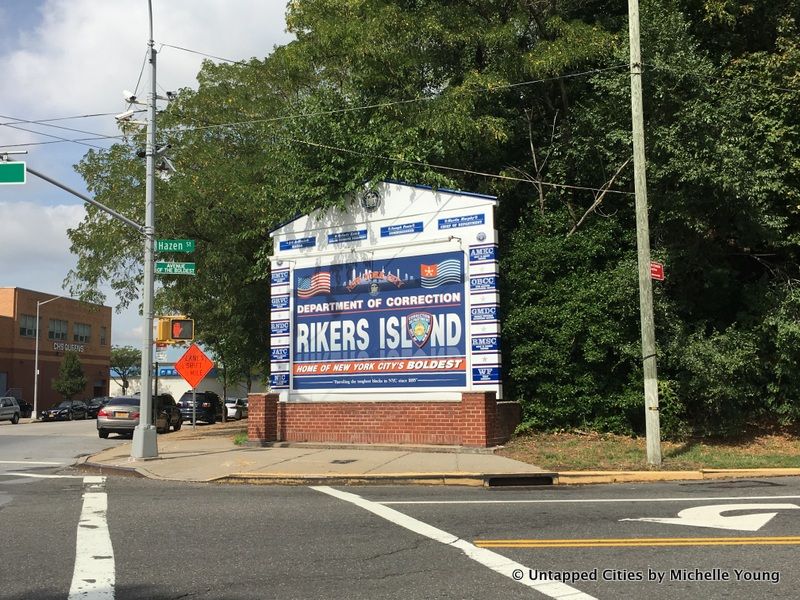100th Anniversary Great Nave Tour at the Cathedral of St. John the Divine
Celebrate the 1925 construction of the stunning nave inside the world's largest Gothic cathedral!


Over the past six weeks, I have been teaching the Bill of Rights to 16-18 year old incarcerated juveniles in the Rikers Island Prison as part of the Rikers Island Project, an advocacy and legal workshop run by Fordham Law School. Lil Wayne was in solitary when we first started, so unfortunately I wasn’t able to teach him his rights. However, we finished up this past Sunday on a high note with a mock trial. The level of involvement and excitement during the trial is a sign of how far we came in gaining their trust. At the conclusion of the workshop, the kids get a certificate of completion which can help reduce their time in Rikers.
Every Sunday, the volunteers leave bright and early from various locations throughout New York City to get to Rikers by 8am. One the first Sunday, I took the 2 train to Atlantic Avenue, Brooklyn at 6:15am to catch a ride with fellow volunteer, James, at 7:00am. There has been high turnover at the Department of Corrections (New York’s Boldest), so getting clearance for ourselves and personal cars has been quite a battle. On the first week, James’ car wasn’t cleared in time, so we left the car in visitor parking before the Rikers Island Bridge and hopped on the Q100 MTA bus to get to the entrance of the prison
Welcome to Rikers, the sign before the bridge:

With car clearance, you can drive over yourself, but you have to first park the car, walk to a trailer in the parking lot to have your registration and IDs checked for everyone in the car. The Rikers Island cat hangs out here and has its own little “prison” -like crate which it lives out of. Sometimes the office gets confused which paperwork is for the current week, so clearance can take some time. Afterwards, we get back in the car, pass the security booth where we show all of our IDs again, along with a newly-acquired vehicle pass.
More threatening ALL-CAPS messages about arrest and prosecution at the bus stop:

The bus with Rikers visitors was extremely crowded for 7:30am on a Sunday:

The fantastic view of the Manhattan skyline and industrial Queens from the bridge:

On the other side of the bridge, there are two main buildings–one with an ID checkpoint and security line and another sparsely-entered one. After going through the ID checkpoint and X-ray scan, James & I discovered that nobody knew where we were supposed to be. We were forwarded from supervisor to supervisor until someone realized we were supposed to be in the building next door. To this day, I am not 100% clear on the difference between the two entrances, but it seems related to whether you are coming in as a “regular visit” or an institutional visit, of which we were the latter. At any rate, here we show our IDs again and are given a plastic badge with a number on it and a invisible hand stamp (shows up only with UV light). We then cross a big parking lot to get to the RNDC (Robert N. Davoren Center). On the last day we were instructed to cross this parking lot in groups of three, “so we wouldn’t get stopped.” This seemed strange, but we don’t generally question correction officers, on principle. Rikers is massive, and even the officers comment on how “far” the RNDC is from the entrance.
Regular visitor entrance, before the X-ray scan:

Even though we arrive at the same time every Sunday, the RNDC entrance has never been manned by the same officer. As a result, there is a lot of confusion every week as to who we are and what we are doing. We get our IDs checked again, sometimes verified against a list of names they have, sometimes not. We handwrite our names into a log book, along with the number on the plastic badge. We put our sparse belongings through an X-ray and pass the metal detector. In this next room, we have to show our IDs again and exchange our plastic badges for a yellow laminated badge. We get led to another security station where we have to show the yellow badges.
At this point, the architecture abruptly changes. Before this, you could have convinced yourself it was a school–the light blue paint, the photos on the wall, the offices. Here, a long hallway stretches seemingly indefinitely with retractable prison bar walls, sanitary beige paint, and defunct x-ray machines. Natural light floods this corridor, but the view outside is of barbed wire. About halfway down this corridor is an incredible mural, but we walk by it so quickly every time that I was mostly struck by the expressionist style of the brushstroke and the contrast it makes with the linearity of the hallway. But I remember there being women in the mural, the one thing that this area of the prison clearly lacks (except for the female correction officers).
After the mural, the architecture shifts again as we descend a staircase into a freezing extension built of plywood walls. This opens onto a narrow concrete walkway with high fences and barbed wire. It’s this moment that conjures up images from the Shawshank Redemption and Le Prophet, because you get a clear message about your own inconsequentiality and the futility of escape. Across another large asphalt area is the building where the juveniles stay. We call it the greenhouse, which may have been a term picked up from the corrections officers. I think it’s an apt term, because it consists of two cavernous but well-lit rooms. Think of inflatable indoor tennis structures but filled with beds, neatly lined in rows. It’s nice to know that these kids are not being housed in jail cells. Even though they may be tried as adults, the system differentiates their age in terms of treatment.
Usually when we arrive, half of the kids are still asleep. Alexi, one of the team leaders from Fordham, rounds them up out of bed. Having worked for Teach for America, she is fearless and they listen to her. There is a semi-circular area at each end of the sleeping hall, used for activities and “welcoming” new inmates. We hold our workshops here. The acoustics of the activity room make it impossible to hear anything unless you are sitting close to each other. This facilitates discussion but there is usually a group of kids that refuse to participate and create noise in the background. The range of personalities is pretty close to what you would find in any classroom–there are the outgoing ones who get into the discussion, the reserved ones who prefer to observe, the withdrawn ones that sit at the outskirts, and the troublemakers in the back of the room. Some seem to eagerly anticipate the class, asking what we are going over that day and looking through the law textbook they got from the prison library. But sometimes the noise gets too much for the less outgoing and they begin to feel isolated when they can’t be heard.
By the time of the mock trial, I noticed that the group of non-participators had shrunk. We handed each person a fact-sheet of the trial and asked them to pick a side: defense or prosecution. I’m not that experienced in law, but I do know how to direct people around and get them excited about things–so I had them gather around and pick roles. We ended up having an overwhelming number supporting the defendant and wanting to be his lawyer. We had a massive legal team of four lawyers (at one point six lawyers were involved) and others playing the defendant or various witnesses. We then coached each person on the facts of the case and to work through what questions they were going to ask or what they would answer on the stand.
The caliber of many of the “lawyers” was truly impressive. Some were methodical, some were dramatic, but they all seemed to relish the opportunity to act. Many “objections” were called, “evidence” was submitted to the judge, and we often had to quiet the legal teams down. At the end, the debate was so heated that each side tried to enter the jury circle, to which we had to call tampering of the jury. The defendant lost his case in a close 6-5 decision, but I reassured everyone that the defense would “appeal.”
I thought that everyone did a great job and made sure to reinforce my sentiments whenever any kid finished questioning or answering. One was so disappointed in his performance that he continued to ask me if he had done a bad job after the case was over. For me, the most rewarding moments came from a few specific kids (names abbreviated for privacy reasons). I met both Y and H on my first day. Both were active in the discussion and we talked about our neighborhoods and family backgrounds–a reaffirmation that despite our different circumstances, there is still much that is shared. Y told me he anticipated to be released soon, but on the last day he was still there. He seemed less involved this time and I was concerned, until he told me that his case had been dismissed and he was going home the next day. I wondered if he was worried about his future outside of Rikers but I did not get a chance to have a more in-depth conversation. We had previously discussed his hopes and goals for the future and I hope he will get a chance to pursue them. On the last day, H asked me if I would visit him between Christmas and New Years, and also chastised me for not showing up the week before (there was a slashing, so the prison was on lockdown). I told him I would try my best and I got his full name, so I plan on bringing him a Christmas gift. A fellow volunteer told me that H’s family doesn’t visit him so hopefully I can make his time in Rikers over the holiday a little less lonely. And finally, perhaps the most touching moment came from one of the quieter kids. He came up to me holding the fact sheet at the end and timidly asked, “Is this the last session?” and asked if he could keep the fact-sheet. He seemed genuinely disappointed it was over, and I do hope for him and the others that we opened up a new avenue of possibility for their future, even if our impact was limited.
There are prisons in every borough, check out ones you might not even have noticed!
Get in touch with the author @untappedmich.
Subscribe to our newsletter